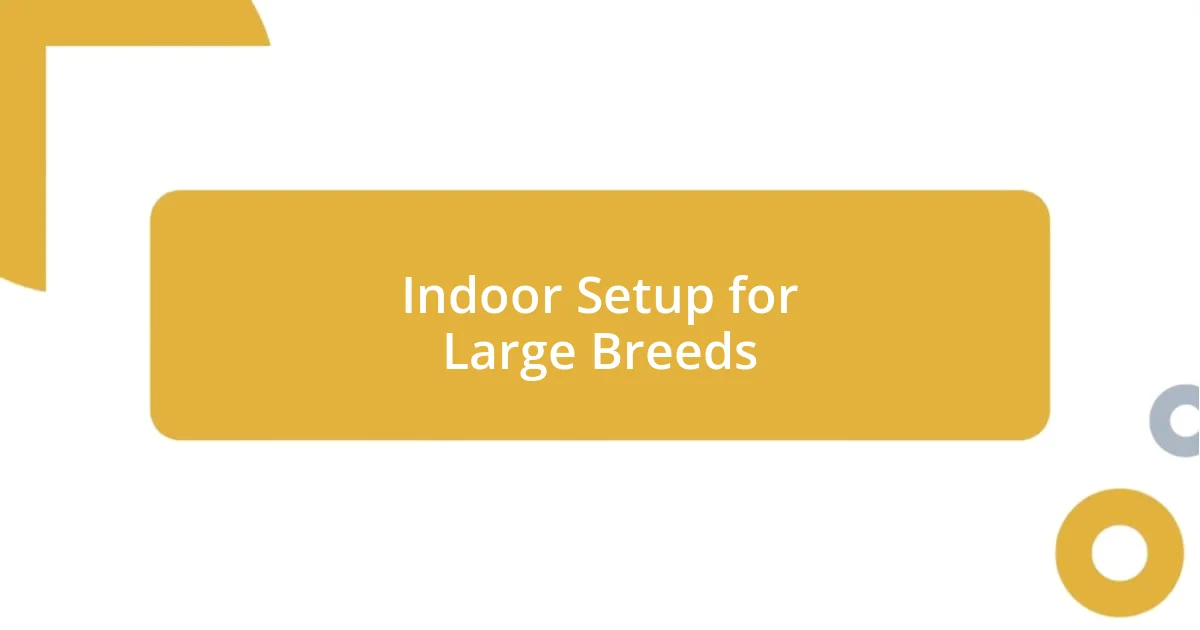Key takeaways:
- Large breeds require special attention to both physical needs, such as joint care and ample space, and emotional needs, including companionship and mental stimulation.
- Creating a conducive indoor and outdoor environment with furniture, safety measures, and accessible amenities is crucial for the comfort and well-being of large dogs.
- Health management involves regular vet check-ups, monitoring weight, and implementing safety precautions in the home to protect large breeds from potential hazards.

Understanding Large Breed Needs
Large breeds have unique needs that can sometimes be overlooked. For instance, I remember when my friend adopted a Great Dane; it was an eye-opener for both of us. I was surprised to learn that their joints require extra care due to their size, which highlighted the importance of a supportive environment for a dog of that stature.
When you think about it, how often do we consider a dog’s emotional needs alongside their physical requirements? Large breeds like Labrador Retrievers or German Shepherds thrive on companionship and physical activity. In my experience, nothing beats the joy of watching them play, but I’ve also seen the stress they can experience when left alone for too long. Establishing a routine that includes mental stimulation, like puzzle toys or training sessions, can make a significant difference in their happiness.
Space is another critical factor. I once visited a friend who lived in a small apartment with their oversized dog, and it was clear that the environment wasn’t ideal. Large breeds need room to move comfortably, so if you’re considering bringing one into your home, think about whether there’s ample space to accommodate their playful nature. Can you imagine the challenges that arise from trying to keep a spirited dog contained in a cramped area? It’s essential to provide an area where they can stretch out and feel at ease.

Choosing Appropriate Space
When choosing the right space for a large breed dog, the layout of your home plays a vital role. I recall visiting a family with a Labrador who seemed constantly on edge, darting around their compact living room. It struck me that the narrow pathways and limited space didn’t cater well to his energetic spirit. Ensuring that your home has open areas where a large dog can roam freely not only keeps them happier but also minimizes the risk of accidents or damage to your belongings.
Here are a few things to consider when selecting appropriate space for your large breed:
- Open Layout: Look for areas with minimal obstacles that allow your dog to move about easily.
- Outdoor Access: A yard or nearby park is beneficial for regular exercise and social interaction.
- Comfort Zones: Designate a cozy corner with proper bedding for relaxation, ensuring it’s easily accessible yet away from high traffic areas.
- Safety Measures: Consider using baby gates or barriers in areas where you need to restrict access, especially with curious pups.
- Adaptable Furniture: Select furniture that can withstand the weight and activity level of a larger dog, such as sturdy coffee tables or pet-friendly sofas.

Essential Amenities for Comfort
Large breeds truly thrive in environments tailored to their comfort. I remember visiting a friend who had outfitted their home with extra-large orthopedic beds specifically designed for larger dogs. The difference it made for their gentle giant, a lovable Bernese Mountain Dog, was remarkable. He would sigh in contentment as he settled onto his plush bed, a clear indication that he appreciated having a dedicated space just for him. When you invest in these comforts, it creates a sense of security for our furry friends.
Another essential amenity is durable, chew-proof furniture. I once had a friend who owned a Doberman, and their couch had seen better days! It became a running joke among us, as it seemed every time I visited, there was more stuffing on the floor. Choosing sturdy, pet-resistant materials prevents this sort of wear and tear. A well-preserved environment keeps both owner and dog happy, avoiding the big expenses of constant replacements.
Last but not least, let’s not forget about the importance of climate control. I had a heart-wrenching experience when a summer heatwave hit, and I noticed how easily my friend’s large breed could tire out under the sun. Ensuring a cool, shaded indoor area can make all the difference in how your dog feels throughout the day. The comfort provided by the right amenities is not just about luxury—it’s about enhancing their well-being.
| Amenity | Importance |
|---|---|
| Orthopedic Beds | Supports joint health and provides comfort |
| Durable Furniture | Withstands wear and tear from larger dogs |
| Climate Control | Prevents overheating and ensures comfort |

Safe Outdoor Areas for Exercise
Creating safe outdoor areas for large breed dogs is essential for their physical and mental well-being. I often think back to the time I took my Great Dane, Charlie, to a local park that had a fenced area specifically for larger dogs. Watching him bound across the grass, his ears flapping in the wind, reminded me of how crucial it is to provide a space where they can stretch their legs and be themselves without the worry of potential dangers from busy roads or other animals.
It’s not just about space; it’s also about the right environment. I once visited a friend who had a spacious backyard surrounded by tall fences. What struck me was how they had integrated natural elements like trees and bushes for shade, making it a comfortable playground for their Mastiff. This thoughtful landscaping not only gave their dog a place to explore and thrive but also created a serene atmosphere for relaxing after playtime. It got me thinking: how often do we consider the emotional needs of our pups as much as the physical spaces we provide for them?
Regular access to these outdoor areas isn’t just a luxury; it’s a necessity. I remember days when my energetic Labrador mix would come bouncing back from our daily walks, exhausted yet content. That fulfilling exercise time in a secure environment not only kept him healthy but also strengthened our bond. Are there local parks or safe backyards in your area where your large breed can truly flourish? Finding such spaces can make all the difference in ensuring our furry companions lead happy and balanced lives.

Indoor Setup for Large Breeds
When setting up an indoor space for larger breeds, I’ve found that creating defined areas just for them can significantly enhance their comfort. For instance, I vividly remember transforming an unused corner of my living room into a cozy nook for my Labrador. By adding a soft, oversized mat and some of his favorite toys, he immediately took ownership of the space. It warmed my heart to see him relax in his little haven, knowing he had a spot in the house that felt like his own.
Accessibility is another critical factor to consider, especially for older or mobility-challenged large breeds. I learned this lesson the hard way when I noticed my senior St. Bernard struggling to jump onto the couch. After investing in a pet ramp, I was amazed at how happily he settled down next to me for our evening TV time. The ramp made a world of difference by allowing him to maintain his independence while being close to the family. Have you thought about how such simple adjustments could greatly impact your dog’s day-to-day life?
Lastly, I can’t stress enough the importance of minimizing hazards in an indoor environment. I remember a close call when my curious Great Pyrenees knocked over a decorative glass vase. Thankfully, it didn’t shatter, but it made me rethink my decor choices. Transitioning to more pet-friendly items like wooden or plastic decor proved beneficial. I wonder, have you ever considered how your canine companions view your home? Keeping their perspective in mind can lead to a more harmonious living space for both pets and owners alike.

Managing Health and Safety
Managing the health and safety of large breed dogs requires vigilance and proactive measures. I’ve found that keeping a close eye on their weight is crucial, especially given how easily large breeds can become overweight. With my Rottweiler, I noticed she was gaining weight a bit too quickly during winter. By adjusting her portions and increasing our walks, I learned that small changes can significantly impact their health. Are you monitoring your dog’s diet closely enough?
Regular veterinary check-ups are another vital aspect of health management. I still remember the time my vet discovered an early-stage hip issue with my Bernese Mountain Dog. Because it was caught early, we could start a treatment plan that improved her quality of life. It opened my eyes to the importance of being proactive rather than reactive when it comes to our pets’ health. Have you scheduled your dog’s annual check-up lately?
Safety also means making sure our living spaces are free of potential dangers. I can’t forget when my energetic puppy somehow managed to get into a pantry and chew on a bag of dog food, causing a bit of chaos! Now, I always secure food items and keep cleaning supplies high up. Reflecting on these experiences, it’s clear that simplifying and puppy-proofing our environments provides peace of mind for both us and our pets. What safety measures have you put in place to protect your large breed?

Tips for Effective Training Techniques
Successful training techniques for larger breeds require patience and a firm yet gentle approach. I still recall the moment my Great Dane mastered the “sit” command after weeks of practice with treats and positive reinforcement. Watching him finally follow through was an incredibly rewarding experience. Have you experienced that joy when your dog grasps a command?
Consistency in commands is key when training larger breeds. I learned this the hard way when I inadvertently mixed up commands. My Labrador seemed to thrive on routines, easily picking up on phrases I used repeatedly. One day, I uttered “stay” while throwing a toy, and he bolted after it instead! That taught me the importance of sticking to the same words and gestures. Have you ever considered how essential consistency can be in your dog’s learning journey?
Incorporating fun and engaging exercises during training can also help maintain your dog’s attention. For instance, I often weave short training sessions into our playtime. We’d toss the frisbee, and every time he brought it back, we’d work on basic commands. It transformed training from a chore into a game! What creative methods have you discovered to keep your dog interested in learning?















